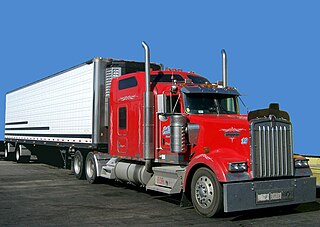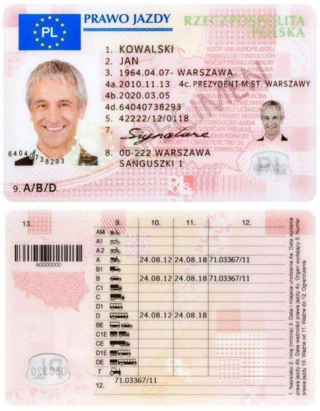
An L-plate is a square plate bearing a sans-serif letter L, for learner, which must be affixed to the front and/or back of a vehicle in many countries if its driver is a learner under instruction, or a motorcycle rider with provisional entitlement to ride restricted motorcycles.

A large goods vehicle (LGV), or heavy goods vehicle (HGV), in the European Union (EU) is any lorry with a gross combination mass (GCM) of over 3,500 kg (7,716 lb). Sub-category N2 is used for vehicles between 3,500 kg and 12,000 kg (26,455 lb) and N3 for all goods vehicles over 12,000 kg as defined in Directive 2001/116/EC. The term medium goods vehicle is used within parts of the UK government to refer to goods vehicles of between 3,500 and 7,500 kg which according to the EU are also "large goods vehicles."

A commercial driver's license (CDL) is a driver's license required in the United States to operate large and heavy vehicles or a vehicle of any size that transports hazardous materials or more than 15 passengers.
A driver's permit, learner's permit, learner's license or provisional license is a restricted license that is given to a person who is learning to drive, but has not yet satisfied the prerequisite to obtain a driver's license. Having a learner's permit for a certain length of time is usually one of the requirements for applying for a full driver's license. To get a learner's permit, one must typically pass a written permit test, take a basic competency test in the vehicle, or both.
Causing death by dangerous driving is a statutory offence in England and Wales, Scotland and Northern Ireland, as well as Hong Kong. It is an aggravated form of dangerous driving. In the UK, it was created by section 1 of the Road Traffic Act 1988, and in Hong Kong it was created by section 36 of the Road Traffic Ordinance.
Many countries have adopted a penalty point or demerit point system under which a person’s driving license is revoked or suspended based on the number of points they’ve accumulated over a specific period of time, points are given for traffic offenses or infringements committed by them in that period. The demerit points schemes of each jurisdiction varies. These demerit schemes are usually in addition to fines or other penalties which may be imposed for a particular offence or infringement, or after a prescribed number of points have been accumulated.

The European driving licence is a driving licence issued by the member states of the European Economic Area (EEA); all 27 EU member states and three EFTA member states; Iceland, Liechtenstein and Norway, which give shared features the various driving licence styles formerly in use. It is credit card-style with a photograph and a microchip. They were introduced to replace the 110 different plastic and paper driving licences of the 300 million drivers in the EEA. The main objective of the licence is to reduce the risk of fraud.
Driving in the United Kingdom is governed by various legal powers and in some cases is subject to the passing of a driving test. The government produces a Highway Code that details the requirements for all road users, including drivers. Unlike most other countries in the world, UK traffic drives on the left.

Driver licences in Australia refer to the official permit required for a person to legally drive a motor vehicle in Australia. The issue of driver licences, alongside the regulation and enforcement of road use, are all managed by state and territory governments.

In Canada, driver's licences are issued by the government of the province or territory in which the driver is residing. Thus, specific regulations relating to driver's licences vary province to province, though overall they are quite similar. All provinces have provisions allowing non-residents to use licences issued by other provinces and territories, out-of-country licences, and International Driving Permits. Many provinces also allow non-residents to use regular licences issued by other nations and countries. Canadian driver's licences are also valid in many other countries due to various international agreements and treaties.
In India, a driving license is an official document that authorises its holder to operate various types of motor vehicles on highways and some other roads to which the public has access. In various Indian states, they are administered by the Regional Transport Authorities/Offices (RTA/RTO). A driving licence is required in India by any person driving a vehicle on any highway or other road defined in the Motor Vehicles Act, 1988. This act sets limits on the minimum age for vehicle operation ranging from 16 to 20, depending on specific circumstances. A modern photo of the driving licence can also serve many of the purposes of an identity card in non-driving contexts such as proof of identity or age.

In the United Kingdom, a driving licence is the official document which authorises its holder to operate motor vehicles on highways and other public roads. It is administered in England, Scotland and Wales by the Driver and Vehicle Licensing Agency (DVLA) and in Northern Ireland by the Driver & Vehicle Agency (DVA). A driving licence is required in England, Scotland, and Wales for any person driving a vehicle on any highway or other "road", as defined in s.192 Road Traffic Act 1988, irrespective of the ownership of the land over which the road passes. Similar requirements apply in Northern Ireland under the Road Traffic Order 1981.
The laws of driving under the influence vary between countries. One difference is the acceptable limit of blood alcohol content before a person is charged with a crime.

A driving licence is required in Malaysia before a person is allowed to drive a motor vehicle of any description on a road in Malaysia under the Road Transport Act 1987, section 26(1). Under section 26(1) of the Road Transport Act, an individual must possess a valid driving licence before being permitted to drive on the road, or can be prosecuted under section 26(2). Upon conviction, the miscreant is liable to fines or jail or both. Driving licence holders are subject to all traffic rules stated in the Road Transport Act 1987.

Driving licences in Hong Kong are issued by the Transport Department. A full driving licence is valid for 10 years and is compulsory in order to drive a motor vehicle. Most driving licences are issued after the applicant passed a driving test for the respective type of vehicles. They may be issued without a test if the applicant is a holder of an overseas driving licence issued on passing a driving test in an approved country.

A driver's license or driving permit is a legal authorization, or the official document confirming such an authorization, for a specific individual to operate one or more types of motorized vehicles—such as motorcycles, cars, trucks, or buses—on a public road. Such licenses are often plastic and the size of a credit card.
A Lebanese driving licence is a driving licence issued by the government of Lebanon. It authorises its holder to operate various types of motor vehicles on highways and some other publicly accessible roads. It is issued by each individual district.

Driving in India is governed by various legal powers and in some cases is subject to the passing of a driving test. The Ministry of Road Transport and Highways, a branch of the Government of India, is the apex body for formulation and administration of the rules, regulations and laws relating to road transport, national highways and transport research, in order to increase the mobility and efficiency of the road transport system in India. Indian traffic drives on the left.

An Icelandic driving licence is a permit issued by the Icelandic Transport Authority authorizing its holder to operate a motorized vehicle. The design conforms to the European driving licence style, and is valid in all countries in the European Economic Area, as well as many others outside Europe. In Iceland the driving age is 17, and 16 is the minimum age to obtian a learner's permit. They are issued in physical form, with an optional digital version also being issued for smartphones. In 2022, 91% of Icelanders had a driving licence.
Vehicle weight is a measurement of wheeled motor vehicles; either an actual measured weight of the vehicle under defined conditions or a gross weight rating for its weight carrying capacity.











